Bifenthrin is a very effective pyrethroid pesticide
I treat the whole yard with a Bifenthrin granual annually... Use to control red ants/ants...
Bifenthrin is a very effective pyrethroid pesticide
Wise choice Keith. Water in well and good residualI treat the whole yard with a Bifenthrin granual annually... Use to control red ants/ants...
I am not a fan of the little red ants called fire ants.
I may stop to visit you one of these years
Tuesday update..
No starters under the tent or in baggies were damaged, BUT one tray of leek babies is gone, wiped out.
The leeks had been ignored until last night so I thought they were unpalatable to the nasties.
Wrong!
So, the tent and zipperlock baggy protected starters survived, which tells me the soil is not where the attack originates, besides I drowned the **** out of them yesterday and I don't think worms have aqua lung rigs...
I do see lizards running around in the yard, I wonder if they munch plants?
I remember those days. I have never seen slugs as those in the Pacific Northwest.In my area, the problem critters are slugs and snails. They'll take out a tomato patch in nothing flat. Probably too hot down there for those?
Get a goose, they love to eat fire ants.I treat the whole yard with a Bifenthrin granual annually... Use to control red ants/ants...
Bifenthrin is a very effective pyrethroid pesticide. However, the XTS formulary is not rated for food crops. The carrier is toxic, not the Bifenthrin itself.
They make food safe formularies of Bifenthrin.Yes, it is against the label recommendations, but I have used it only on the emerging plants for years, not on fruiting plants or leaf plants like spinach or collards. Otherwise the insects here take over. Never had a problem, just a dragging leg and twitches. I may switch over to Fertilome next year, and see if the garden can survive.
Talstar is one formulation that is safe to use in kitchen areas.They make food safe formularies of Bifenthrin.
Bifenthrin is qausi organic. It is a pyrethroid meaning it is a synthesized version of pyrethrin which is organic.


